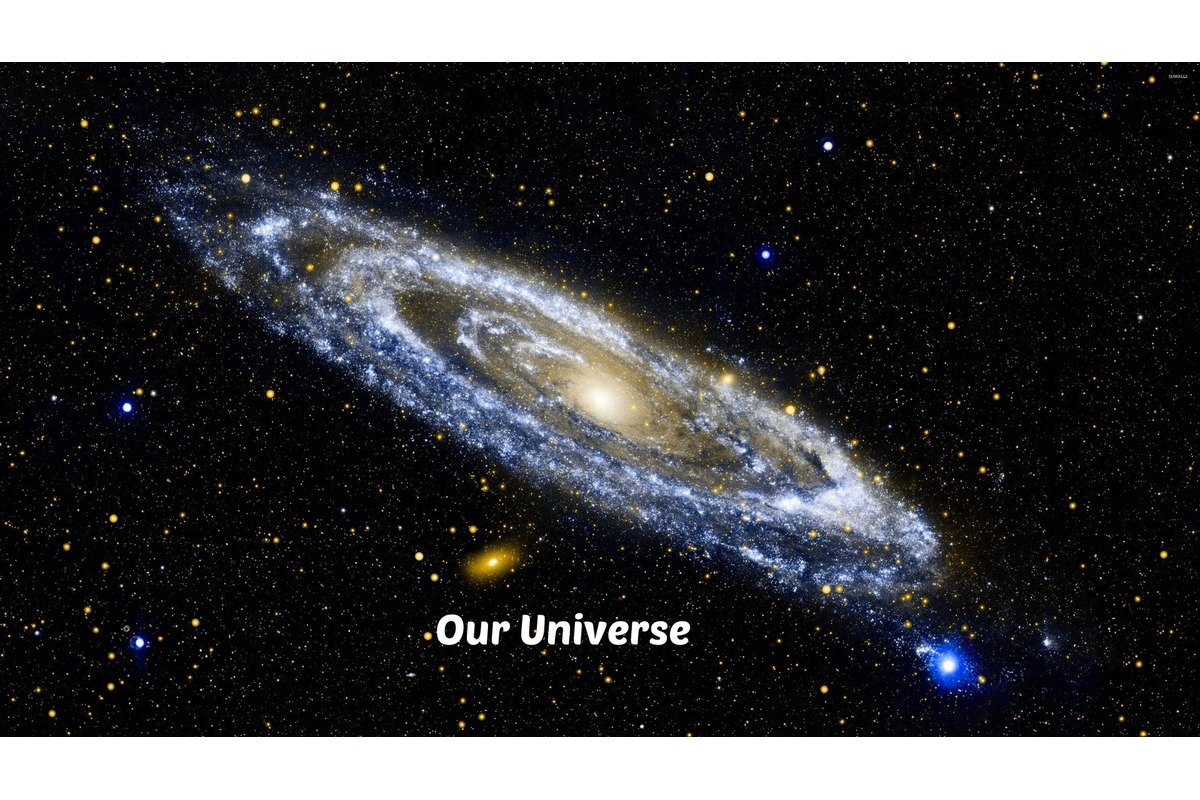Our Universe
Our universe, a vast expanse of unimaginable proportions, holds within it mysteries and wonders beyond comprehension. From the tiniest subatomic particles to the grandest galaxies, the universe is a tapestry of cosmic phenomena that has fascinated humanity for millennia.

- Galaxies: Galaxies are vast systems comprising stars, stellar remnants, interstellar gas, dust, and dark matter bound together by gravity. They come in different shapes and sizes, ranging from spiral and elliptical galaxies to irregular ones.
- Stars: Stars are luminous celestial bodies primarily composed of hydrogen and helium, undergoing nuclear fusion to generate energy. They serve as the primary sources of light and heat in the universe and play a crucial role in the formation of planetary systems.
- Planets: Planets are solid or gaseous bodies orbiting stars, with some possessing conditions conducive to the emergence and sustenance of life. Our solar system, for instance, consists of eight planets, including Earth, each exhibiting distinct characteristics and compositions.
- Moons: Moons, also known as natural satellites, are celestial bodies that orbit planets. They come in various sizes and shapes and often play significant roles in shaping the geology and dynamics of their parent planets.
- Asteroids and Comets: Asteroids and comets are remnants from the early solar system, consisting of rock, metal, and ice. Asteroids primarily orbit the Sun within the asteroid belt between Mars and Jupiter, while comets follow highly elliptical orbits, often originating from the distant Kuiper Belt or Oort Cloud.
- Interstellar Medium: The interstellar medium refers to the vast expanse of gas, dust, and plasma that fills the space between stars and galaxies. It serves as the raw material for star formation and plays a crucial role in the evolution of galaxies.
- Dark Matter: Dark matter is a mysterious and invisible form of matter that comprises approximately 27% of the universe’s total mass-energy content. Although it does not emit, absorb, or reflect light, its presence is inferred from its gravitational effects on visible matter.
- Dark Energy: Dark energy is an enigmatic force that permeates the universe and is thought to be responsible for the observed accelerated expansion of the cosmos. Unlike dark matter, dark energy exerts a repulsive gravitational effect, driving galaxies apart on cosmic scales.
- Cosmic Radiation: Cosmic radiation encompasses a variety of high-energy particles, including protons, electrons, and photons, that pervade the universe. It originates from sources such as supernovae, active galactic nuclei, and cosmic ray interactions in the interstellar medium.
- Black Holes: Black holes are regions of spacetime where gravitational forces are so intense that nothing, not even light, can escape their gravitational pull. They form from the collapse of massive stars and are believed to play a crucial role in the evolution of galaxies.
These components collectively contribute to the rich tapestry of the universe, shaping its structure, evolution, and ultimate fate. Their interactions and dynamics provide insights into the underlying laws of physics and the fundamental processes governing cosmic phenomena.
Distance Measurements:
-
- Light-years: Light-year is a unit of measurement representing the distance light travels in one year, approximately 9.461 trillion kilometers (5.879 trillion miles). It is commonly used to describe distances between celestial objects.
- Parsecs: Parsec is another unit of distance measurement, equivalent to approximately 3.26 light-years. It is often used in astronomy to express distances to nearby stars and galaxies.
- Redshift: Redshift is a phenomenon observed in the light emitted by distant galaxies, where the wavelength of light is stretched due to the expansion of the universe. It serves as a crucial indicator of cosmic distance and the rate of cosmic expansion.
Size and Mass Measurements:
-
- Solar Mass: Solar mass is a unit of measurement representing the mass of the Sun, approximately 1.989 × 10^30 kilograms. It is used to describe the masses of stars, galaxies, and other celestial bodies.
- Astronomical Unit (AU): Astronomical unit is a unit of length used in astronomy, equal to the average distance between the Earth and the Sun, approximately 149.6 million kilometers (92.96 million miles). It is often used to express distances within the solar system.
Temperature Measurements:
-
- Kelvin (K): Kelvin is the primary unit of temperature measurement in astronomy, where temperatures are often extremely high or low. It is an absolute temperature scale where zero Kelvin represents absolute zero, the lowest possible temperature.
- Electron Volts (eV): Electron volts are a unit of energy commonly used in particle physics and astrophysics to describe the kinetic energy of particles or the temperatures of cosmic environments.
Time Measurements:
-
- Cosmic Time Scales: In cosmology, time measurements often refer to cosmic time scales, spanning billions or even trillions of years. These time scales are used to describe the evolution of the universe, the lifetimes of stars and galaxies, and the occurrence of cosmic events.
Angular Measurements:
-
- Degrees, Arcminutes, and Arcseconds: Angular measurements are used to describe the apparent sizes and positions of celestial objects in the sky. A degree is divided into arcminutes (1/60th of a degree) and arcseconds (1/60th of an arcminute), providing finer angular resolution for precise astronomical observations.
These measurement types enable astronomers and physicists to quantify the vastness and intricacies of the universe, unravel its mysteries, and deepen our understanding of its structure and evolution. By employing sophisticated instruments and techniques, scientists continue to push the boundaries of knowledge and explore the cosmos on ever-larger scales.
Universe Theories
- Big Bang Theory
The Big Bang Theory stands as the prevailing explanation for the origin of the universe among cosmologists. According to this theory, the universe originated from an extremely hot and dense state approximately 13.8 billion years ago. At this singular moment, all matter and energy were concentrated into an infinitesimal point, before rapidly expanding and giving rise to the universe as we know it. The Big Bang Theory is supported by a wealth of observational evidence, including the cosmic microwave background radiation and the observed expansion of the universe.
- Inflationary Cosmology
Building upon the foundations of the Big Bang Theory, inflationary cosmology proposes that the universe underwent a period of exponential expansion in the immediate aftermath of the Big Bang. This rapid expansion, driven by a hypothetical field known as the inflation, would have smoothed out irregularities in the early universe and provided an explanation for its remarkable uniformity on large scales. Inflationary cosmology offers an elegant solution to several puzzles of standard cosmology, although the precise mechanism behind inflation remains a subject of ongoing research.
- Multiverse Hypothesis
The multiverse hypothesis posits the existence of a vast ensemble of parallel universes, each with its own set of physical laws and properties. Within this framework, our universe is but one among many, each branching off from a common cosmic origin. Multiverse theories arise from certain interpretations of quantum mechanics and inflationary cosmology, suggesting that the universe may be part of a larger cosmic landscape beyond our observational reach. While the multiverse hypothesis remains highly speculative, it offers a tantalizing solution to the fine-tuning problem and other cosmological mysteries.
- String Theory and M-theory
String theory and its successor, M-theory, represent ambitious attempts to formulate a unified description of the fundamental forces and particles in the universe. According to these theories, the fundamental constituents of reality are not point-like particles but rather tiny, vibrating strings or membranes. By extending the fabric of spacetime into higher-dimensional realms, string theory aims to reconcile quantum mechanics with general relativity and provide a comprehensive framework for understanding the cosmos. While string theory remains a subject of active research, its implications for the origin and structure of the universe are profound and far-reaching.
- Quantum Fluctuations
Quantum fluctuations, arising from the inherent uncertainty of quantum mechanics, may have played a crucial role in the birth of the universe. According to some theories, including the Hartle-Hawking no-boundary proposal, the universe emerged spontaneously from a quantum vacuum fluctuation, akin to a bubble forming in a boiling pot of water. In this view, the laws of physics themselves may have arisen from the primordial quantum foam, giving rise to space, time, and matter in a cosmic genesis event. Quantum cosmology offers a radical reinterpretation of the origin of the universe, emphasizing the role of quantum uncertainty and indeterminacy in cosmic creation.






nice
informative